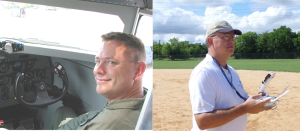There isn’t a day that goes by now without hearing about someone doing something with a small UAV that they shouldn’t. From aerial drones loitering around major airports like New York’s JFK to camera drones interfering with fire attack helicopters battling California’s wildfires, even quad-copters landing on the South Lawn of the White House, it seems like the folks flying them are painfully ignorant of the rules.
What?! There are rules for flying little radio-controlled aircraft? You bet! Fortunately, most small UAV flyers are responsible aviators; they know and abide by the general flying rules contained in Part 91 of the Consolidated Federal Regulations. But there continues to be those flyers who cannot or choose not to take a hint.
Whether their irresponsible acts are from negligence or stupidity, the fact remains that the acts of those who endanger the safety of the passengers and crew aboard an airliner or cause millions of dollars in property damage by thwarting the efforts of firefighting aircraft are just as criminal as playing chicken with an oncoming bus full of passengers or intentionally blocking a string of responding firetrucks. There must be zero tolerance of this kind of aerial buffoonery.
The cure to aerial ignorance starts with flight instructors.
Education and inclusion into the aviation community is not going to stop criminals who are determined to do no-good. However, what a CFI can do is educate those who are ignorant of the rules. Flight instructors are the first line of defense against foolish flying at our local airports. We must broaden our sphere of influence to cover both civil manned aviation and unmanned aviation.
Talking with a nearby fellow RC flyer, I learned just how misunderstood the aviation regulatory structure is with the recent recruits to the ranks of unmanned aviation. “Since the FAA hasn’t published this new Part 107 regulation yet, there are no regulations that cover RC flyers,” this fellow told me at a local model aircraft shop. “It’s the Wild West out there.”
Nothing could be further from the truth.
It doesn’t take a jailhouse lawyer to figure out that anything that flies is covered by a regulation. The problem is getting the uninformed to read 14 CFR 91.1 (a) which states:
“…this part prescribes rules governing the operation of aircraft (other than moored balloons, kites, unmanned rockets, and unmanned free balloons, which are governed by part 101 of this chapter, and ultralight vehicles operated in accordance with part 103 of this chapter) within the United States, including the waters within 3 nautical miles of the U.S. coast.”
Yes, there is also Part 336 of Public Law 112-95 which provides for recreational flights of unmanned aircraft. But here’s the kicker—it doesn’t change the need for UAV flyers to follow Part 91. Why? Because Part 336 begins with this statement:
“Notwithstanding any other provision of law relating to the incorporation of unmanned aircraft systems into Federal Aviation Administration plans and policies, including this subtitle….”
Part 91.1 in defining which aircraft the general flying rules apply to sets forth the “law relating to the incorporation of unmanned aircraft systems….”
There was Advisory Circular 91-57 that dealt specifically with recreational flight and model aircraft—radio-controlled or otherwise. Part 336 for all intents and purposes did away with AC 91-57. However, the fact that the advisory circular provided further guidance from Part 91 (hence the “91” in 91-57) means that Part 91 applied to recreational flights of model aircraft before Public Law 112-95 came into existence. Part 91 is the regulatory source for general flight rules to meet the requirements by law under 49 USC 40101—a provision of law. Therefore, there is a clear line of regulatory responsibility that was previously established for recreational model aircraft flyers to meet the same level of care for safe flight operations as manned aircraft aviators. If anything, Part 336 clearly established that model aircraft flyers may not interfere with must give way to manned aircraft.
The requirement for recreational model aircraft flyers to abide by Part 91 hasn’t changed. It has only been enhanced with the additional requirements Part 336. If there has ever been a time when CFIs are needed to educate our newest users of the National Airspace System in the safe and proper sharing of the skies, it is now.
By Dave Hook, CFII, ATP, AGI



